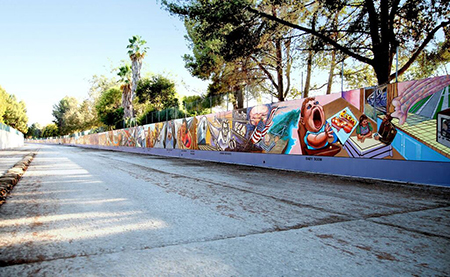
Continuing through December 16, 2017
Judith Baca is a force of nature. The artist and activist is responsible for approximately 250 murals in Los Angeles that have captured the spirit of neighborhoods, while mentoring and influencing scores of young people who have served as collaborators. Painting murals for close to fifty years, her ability to understand a community and to create meaningful work that speaks to the issues that matter is uncanny. One of her most impressive accomplishment is "The Great Wall of Los Angeles," a 2,754 foot-long mural located along the Tujunga Flood Control Channel in the San Fernando Valley, which has taken on a significant life of its own since its inception in 1974.
"Experiments in Concrete and Collaboration: Judith F. Baca’s Reconfiguring of The Great Wall of Los Angeles" seeks to tell the story of this monumental work and highlights Baca’s process of engaging and challenging the community that helped her create the mural. The exhibit utilizes the archives of the Social and Public Art Resource Center (SPARC), which oversees the mural and features drawings, photographs of the process, and assorted objects associated with its creation. Baca co-founded SPARC just before she started work on the wall, and the organization since that time has focused on producing, preserving and hosting education programs related to community-based art projects and events.
"The Great Wall of Los Angeles" has been recognized as one of the most significant murals in the world. Referenced by historians, critics, and scholars for its collaborative methodology and role in the development of murals in Los Angeles. The Army Corps of Engineers contacted Baca in 1974 regarding a beautification project for a retaining wall. Completed over the course of seven summers (1978-1984), it involved over four hundred youth and family members from the community. The exhibit features photos of these early days and the diverse voices that contributed towards its completion.
Los Angeles is a city defined by concrete, the L.A. River being a prime example. Baca sees the concrete river as a hardening of the arteries of the land. Her concept for "The Great Wall" was to create a narrative history of the city of Los Angeles. Rather than follow the typical highlights one might find on a conventional timeline, Baca authored an alternative history, one that focuses on people who have been overlooked and in some cases forgotten. Sometimes referred to as "history from below," it’s a perspective that helped change the way we understand the past. Baca writes on the SPARC website: “I designed this project as an artist concerned not only with the physical aesthetic considerations of a space, but the social, environmental and cultural issues affecting the site as well.” Recruiting a team of artists that partnered with community members and leading content experts, the refining process from inspiration to critique and finally execution was thorough.
Its timeline depicts prehistoric natives in California and continues through the 1950s. Organized in vignettes, it unfurls in chronological order so visitors can walk along the wall and follow the narrative. The pre-historic (ca. 20,000 BC.) sections feature the La Brea Tar Pits and pre-historic mammals like the woolly mammoth and a saber-toothed tiger. It quickly transitions into a Chumash Village (ca. 1,000 A.D.) and the Native American people who inhabited sections of Southern California. This is followed by dozens and dozens of fragmented historical and sociopolitical events, including migrants coming to California, Japanese internment camps, the plight of Jewish refugees and Mexican-Americans being deported. The vignettes of broad scale events like the Great Depression and the development of the labor movement focus on those who struggled: two men warm their hands over a burning trashcan in one vignette, while another frame features an individual with a strike sign amongst a line of protestors.
The research process for each section was labor intensive and was carefully planned through workshops, lectures, and consulting community members. Selection of the proper materials involved at every stage in addition to organizing scaffolding and permits, required strategic relationships, planning, and managing of resources and people. Baca functioned as an activist, historian, artist, community leader, politician, engineer, among other roles to see the work to completion. While the exhibit explores "The Great Wall," it’s Baca that shines in the end due to her tenacity, ingenuity and inclusive spirit. The documentation conveys but still only hints at the complexity of this undertaking.
In conjunction with the exhibit, a significant text was organized entitled "BACA: Art, Collaboration & Mural Making.” The artist authored the foreword, in which she writes: “For me, a mural is not an easel painting made large. A mural is a work of art created in relatedness: relatedness to the architecture on which it is placed, to the people for whom it is painted. It is related to those who lift the brushes to help paint it.” Thought to be the longest mural in the world, Baca still has plans to extend the work by adding sections that address the second half of the 20th century. Through "The Great Wall," Baca’s art process contributed to what is now referred to as social practice. Although she couldn't know at the time, it has defined her career as an artist.
